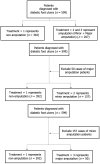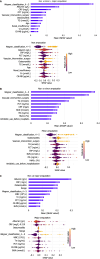Predictive model and risk analysis for outcomes in diabetic foot ulcer using eXtreme Gradient Boosting algorithm and SHapley Additive exPlanation
- PMID: 40697589
- PMCID: PMC12278075
- DOI: 10.4239/wjd.v16.i7.104789
Predictive model and risk analysis for outcomes in diabetic foot ulcer using eXtreme Gradient Boosting algorithm and SHapley Additive exPlanation
Abstract
Background: Diabetic foot ulcer (DFU) is a serious and destructive complication of diabetes, which has a high amputation rate and carries a huge social burden. Early detection of risk factors and intervention are essential to reduce amputation rates. With the development of artificial intelligence technology, efficient interpretable predictive models can be generated in clinical practice to improve DFU care.
Aim: To develop and validate an interpretable model for predicting amputation risk in DFU patients.
Methods: This retrospective study collected basic data from 599 patients with DFU in Beijing Shijitan Hospital between January 2015 and June 2024. The data set was randomly divided into a training set and test set with fivefold cross-validation. Three binary variable models were built with the eXtreme Gradient Boosting (XGBoost) algorithm to input risk factors that predict amputation probability. The model performance was optimized by adjusting the super parameters. The predictive performance of the three models was expressed by sensitivity, specificity, positive predictive value, negative predictive value and area under the curve (AUC). Visualization of the prediction results was realized through SHapley Additive exPlanation (SHAP).
Results: A total of 157 (26.2%) patients underwent minor amputation during hospitalization and 50 (8.3%) had major amputation. All three XGBoost models demonstrated good discriminative ability, with AUC values > 0.7. The model for predicting major amputation achieved the highest performance [AUC = 0.977, 95% confidence interval (CI): 0.956-0.998], followed by the minor amputation model (AUC = 0.800, 95%CI: 0.762-0.838) and the non-amputation model (AUC = 0.772, 95%CI: 0.730-0.814). Feature importance ranking of the three models revealed the risk factors for minor and major amputation. Wagner grade 4/5, osteomyelitis, and high C-reactive protein were all considered important predictive variables.
Conclusion: XGBoost effectively predicts diabetic foot amputation risk and provides interpretable insights to support personalized treatment decisions.
Keywords: Amputation risk stratification; Clinical risk prediction; Diabetic foot ulcer; Machine learning; SHapley Additive exPlanation; eXtreme Gradient Boosting.
©The Author(s) 2025. Published by Baishideng Publishing Group Inc. All rights reserved.
Conflict of interest statement
Conflict-of-interest statement: The authors declare that they have no conflicts of interest.
Figures





Similar articles
-
Supervised Machine Learning Models for Predicting Sepsis-Associated Liver Injury in Patients With Sepsis: Development and Validation Study Based on a Multicenter Cohort Study.J Med Internet Res. 2025 May 26;27:e66733. doi: 10.2196/66733. J Med Internet Res. 2025. PMID: 40418571 Free PMC article.
-
Serum calcium-based interpretable machine learning model for predicting anastomotic leakage after rectal cancer resection: A multi-center study.World J Gastroenterol. 2025 May 21;31(19):105283. doi: 10.3748/wjg.v31.i19.105283. World J Gastroenterol. 2025. PMID: 40497096 Free PMC article.
-
Interpretable prediction of hospital mortality in bleeding critically ill patients based on machine learning and SHAP.BMC Med Inform Decis Mak. 2025 Jul 15;25(1):263. doi: 10.1186/s12911-025-03101-9. BMC Med Inform Decis Mak. 2025. PMID: 40665292 Free PMC article.
-
Psychological interventions for treating foot ulcers, and preventing their recurrence, in people with diabetes.Cochrane Database Syst Rev. 2021 Feb 8;2(2):CD012835. doi: 10.1002/14651858.CD012835.pub2. Cochrane Database Syst Rev. 2021. PMID: 35653236 Free PMC article.
-
A systematic review and individual patient data meta-analysis of prognostic factors for foot ulceration in people with diabetes: the international research collaboration for the prediction of diabetic foot ulcerations (PODUS).Health Technol Assess. 2015 Jul;19(57):1-210. doi: 10.3310/hta19570. Health Technol Assess. 2015. PMID: 26211920 Free PMC article.
References
-
- Armstrong DG, Boulton AJM, Bus SA. Diabetic Foot Ulcers and Their Recurrence. N Engl J Med. 2017;376:2367–2375. - PubMed
-
- Jeffcoate WJ, Vileikyte L, Boyko EJ, Armstrong DG, Boulton AJM. Current Challenges and Opportunities in the Prevention and Management of Diabetic Foot Ulcers. Diabetes Care. 2018;41:645–652. - PubMed
LinkOut - more resources
Full Text Sources
Research Materials

